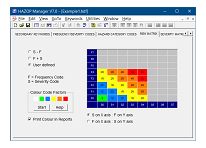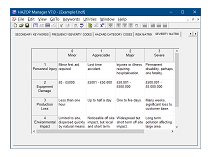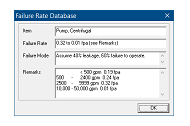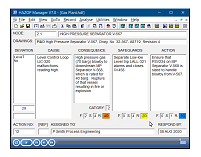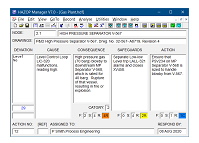Features and Facilities (Page 2 of 3)
-
Text Macro files may be prepared for use during a study. They contain often-used phrases that can be automatically typed by pressing the appropriate 'hot keys', thus speeding-up the process of recording the meeting minutes.
-
Potential problems recorded during a meeting may be categorised by expected Frequency of occurrence, Severity of the consequences and the appropriate Hazard Category (e.g. Personnel injury, Equipment damage, etc.). Descriptions associated with all of these codes are fully editable. The software can also calculate a Risk factor. The matrix employed may be automatically configured using two standard formulae, or alternatively can be customised according to your own method of calculating risk. The axis upon which the Frequency and Severity classification codes are displayed can also be selected. Risk factors can optionally be colour-coded for easy visual identification when scanning through the data file.
-
A Severity Matrix can be used to maintain objectivity and consistency in the assignment of those codes. This matrix can be speedily displayed at any time during the study meeting by the simple click of a mouse button.
- A Failure Rates database is also included. This may be interrogated during the study meeting to ascertain the likely frequency with which an item of equipment may malfunction.
- You may optionally re-assess risk after taking into account both the existing protection, and if necessary, the recommended action. This assists the study team in deciding whether an action is necessary, and if it is, validates the proposed action as being adequate.
 Previous page Next page
Previous page Next page 


